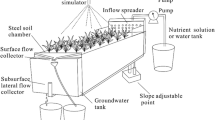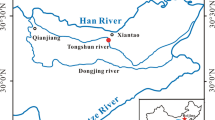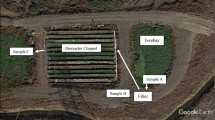Abstract
Surface water contamination can often be reduced by passing runoff water through perennial grass filters. Research was conducted in 2006 to 2008 to evaluate the size of cool season grass filters consisting primarily of tall fescue (Festuca arundinacea Schreb) with some orchard grass (Dactylis glomerata L.) relative to drainage area size in reducing runoff sediment and phosphorus (P). The soil was Pohocco silt loam Typic Eutrochrepts with a median slope of 5.5 %. The grass filters occupying 1.1 and 4.3 % of the plot area were compared with no filter with four replications. The filters were planted in the V-shaped plot outlets which were 3.7 × 11.0 m in size. The filter effect on sediment and P concentration was determined from four natural runoff events when nearly all plots had runoff. Filter effect on runoff volume and contaminant load was determined using total runoff and composites of samples collected from 12 runoff events. Sediment concentration was reduced by 25 % with filters compared with no filter (from 1.10 to 1.47 g L−1), but P concentration was not affected. The 1.1 and 4.3 % filters, respectively, compared with having no grass filter, reduced: runoff volume by 54 and 79 %; sediment load by 67 and 84 % (357 to 58 kg ha−1); total P load by 68 and 76 % (0.58 to 0.14 kg ha−1); particulate P (PP) load by 66 and 82 % (0.39 to 0.07 kg ha−1); and dissolved reactive P (DRP) load by 73 and 66 % (0.2 to 0.07 kg ha−1), respectfully. A snowmelt runoff event had 56 % greater DRP concentration compared with rainfall-induced runoff events. Grass filters reduced sediment and P load largely by reducing runoff volume rather than reducing concentration. Well-designed and well-placed grass filters that occupy 1.0 to 1.5 % of the drainage area and intercept a uniform flow of runoff from a drainage area can reduce sediment and nutrient loss in runoff by greater than 50 %.





Similar content being viewed by others
References
Abu-Zreig, M., Ruda, R. P., Whiteley, H. R., Lalonde, M. N., & Kaushik, N. K. (2003). Phosphorus removal in vegetated filter strip. Journal of Environmental Quality, 32, 613–619.
Blanco-Canqui, H., Gantzer, C. J., Anderson, S. H., Alberts, E. E., & Thompson, A. L. (2004). Grass barrier and vegetative filter strip effectiveness in reducing runoff, sediment, nitrogen, and phosphorus loss. Soil Science Society of America Journal, 68, 1670–1678.
Clausen, J. C., Guillard, K., Sigmund, C. M., & Dors, K. M. (2000). Water quality changes from riparian buffer restoration in Connecticut. Journal of Environmental Quality, 29, 1751–1761.
Culley, J. L., & Bolton, E. F. (1983). Suspended solids and phosphorus loads from a clay soil: II. Watershed study. Journal of Environmental Quality, 12, 498–503.
Daniels, R. B., & Gilliam, J. W. (1996). Sediment and chemical load reduction by grass and riparian filters. Soil Science Society of America Journal, 60, 246–251.
Dillaha, T. A., Sherrard, J. H., & Lee, D. (1986). Long-term effectiveness and maintenance of vegetative filter strips. Virginia Water Resources Research Center, Virginia Polytechnic Institute and State University, Blacksburg Bulletin 153.
Dillaha, T. A., Reneau, R. B., Mostaghimi, S., & Lee, D. (1989). Vegetative filter strips for agricultural nonpoint source pollution control. Transactions of ASAE, 32, 513–519.
Dorioz, J. M., Wang, D., Poulenard, J., & Trévisan, D. (2006). The effect of grass buffer strips on phosphorus dynamics—A critical review and synthesis as a basis for application in agricultural landscapes in France. Agriculture, Ecosystems & Environment Journal, 117, 4–21.
Dosskey, M. G., Helmers, M. J., Eisenhauer, D. E., Franti, T. G., & Hoagland, K. D. (2002). Assessment of concentrated flow through riparian buffers. Journal of Soil and Water Conservation, 57, 336–343.
Dosskey, M. G., Hoagland, K. D., & Brandle, J. R. (2007). Changes in filter strip performance over ten years. Journal of Soil and Water Conservation, 62, 21–32.
Dosskey, M. G., Helmers, M. J., & Eisenhauer, D. E. (2008). A design aid for determining width of filter strips. Journal of Soil and Water Conservation, 63, 232–241.
Erickson, J. E., Cisar, J. L., Volin, J. C., & Snyder, G. H. (2001). Comparing nitrogen runoff and leaching between newly established St. Augustine grass turf and an alternative residential landscape. Crop Science, 41, 1889–1895.
Flanagan, D. C., Foster, G. R., Neibling, W. H., & Burt, J. P. (1989). Simplified equations for filter strip design. Transactions of ASAE, 32, 2001–2007.
Foster, G. R. (1982). Modeling the erosion process. 297–380. In C. T. Haan et al. (Eds.) Hydrologic modeling of small watersheds. ASAE Monographs No. 5. St. Joseph, MI.
Fox, G. A., & Sabbagh, G. J. (2009). Comment on ‘Major factors influencing the efficacy of vegetated buffers on sediment trapping: A review and analysis’, by Liu X, Zhang X, Zhang M in J. Environ. Qual. 2008 37: 1667–1674. Journal of Environmental Quality, 38, 1–3.
Gharabaghi, B., Rudra, R. P., Whiteley, H. R., & Dickingson, W. T. (2002). p. 289–302. In W. James (Ed.) Development of a management tool for vegetative filter strips. Best modeling practices for urban water systems. CHI Monograph 10, Guelph, Ontario, Canada.
Gilley, J. E., Eghball, B., Kramer, L. A., & Moorman, T. B. (2000). Narrow grass hedge effects on runoff and soil loss. Journal of Soil and Water Conservation, 55, 190–196.
Ginting, D., Moncrief, J. F., Gupta, S. C., & Evans, S. D. (1998). Interaction between manure and tillage system on phosphorus uptake and runoff losses. Journal of Environmental Quality, 27, 1403–1410.
Gitau, M. W., Gburek, W. J., & Jarrett, A. R. (2005). A tool for estimating best management practice effectiveness for phosphorus pollution control. Journal of Soil and Water Conservation, 60, 1–10.
Gumiere, S. J., Bissonnais, Y. L., Raclot, D., & Cheviron, B. (2010). Vegetated filter effects on sedimentological connectivity of agricultural catchments in erosion modelling: A review. Earth Surface Processes and Landforms, 36, 3–19.
Haan, C. T., Barfield, B. J., & Hayes, J. C. (1994). Design hydrology and sedimentology for small catchments (p. 588). San Diego: Academic.
Hayes, J. C., Barfield, B. J., & Barnhisel, R. I. (1984). Performance of grass filters under laboratory and field conditions. Transactions of ASAE, 27, 1321–1331.
Helmers, M. J., Eisenhauer, D. E., Dosskey, M. G., & Franti, T. G. (2002). Modeling vegetative filter performance with VFSMOD. ASAE Meeting Paper No. MC02-308.
Helmers, M. J., Isenhart, T. M., Dosskey, M., Dabney, S. M., & Strock, J. S. (2008). Buffers and vegetative filter strips. USDA Forest Service/UNL Faculty Publications. Paper 20. http://digitalcommons.unl.edu/usdafsfacpub/20.
Jasen, T., Kevin, T., Esther, S., Andrea, K., & Don, N. (2011). Spring snowmelt impact on phosphorus addition to surface runoff in the Northern Great Plains. Better Crops/Vol. 95, No. 1)
Lee, D., Dillaha, T. A., & Sherrard, J. H. (1989). Modeling phosphorus transport in grass filter strips. Journal of Environmental Engineering, 115, 409–427.
Li, L., & Simonovic, S. P. (2002). System dynamics model for predicting floods from snowmelt in North American prairie watersheds. Hydrological Processes, 16, 2645–2666.
Liu, X., Zhang, X., & Zhang, M. (2008). Major factors influencing the efficacy of vegetated buffers on sediment trapping: A review and analysis. Journal of Environmental Quality, 37, 1667–1674.
Magette, W. L., Brinsfield, R. B., Palmer, R. E., & Wood, J. D. (1989). Nutrient and sediment removal by vegetated filter strips. Transactions of ASAE, 32, 663–667.
Mankin, K. R., Ngandu, M. D., Barden, C. J., Hutchinson, S. L., & Geyer, W. A. (2007). Grass–shrub riparian buffer removal of sediment, phosphorus, and nitrogen from simulated runoff. Journal of the American Water Resources Association, 43, 1108–1116.
Murphy, J., & Riley, J. P. (1962). A modified single solution method for the determination of phosphate in natural waters. Analytica Chimica Acta Journal, 27, 31–36.
Nearing, M. A. (2004). Soil erosion and conservation. In Environmental modelling: Finding simplicity in complexity. Chichester: Wiley. ISBN 100-471-49618-9.
Neibling, W. H., & Alberts, E. E. (1979). Composition and yield of soil particles transported through sod strips. ASAE Paper No. 79–2065. ASAE, St. Joseph, MI.
Nighman, D., & Harbor, J. (1997). Trap efficiency of a storm water basin with and without baffles. Proceeding International Erosion Control Association, 28, 469–483.
Olsen, S. R., & Sommers, L. E. (1982). Phosphorus. pp. 403–430. In A. L. Page, R. H. Miller, and D. R. Keeney (Eds.), Methods of soil analysis. 2nd ed. Agronomy Series No. 9, Part 2. Soil Science Society of America Journal, Madison, WI.
Petrovic, A. M. (1990). The fate of nitrogenous fertilizers applied to turfgrass. Journal of Environmental Quality, 19(1), 1–14.
Pote, D. H., & Daniel, T. C. (2000). Analyzing for dissolved reactive phosphorus in water samples. p. 91–93. In G. M. Pierzynski (Ed.), Methods of phosphorus analysis for soils, sediments, residuals, and waters. Southern Cooperative Series Bull. No. 396. SERA-IEG 17, USDA-CSREES Regional Committee.
Rachman, A., Anderson, S. H., Gantzer, C. J., & Alberts, E. E. (2004a). Soil hydraulic properties influenced by stiff-stemmed grass hedge systems. Soil Science Society of America Journal, 68, 1386–1393.
Rachman, A., Anderson, S. H., Gantzer, C. J., & Alberts, E. E. (2004b). Influence of stiff-stemmed grass hedge systems on infiltration. Soil Science Society of America Journal, 68, 2000–2006.
SAS Institute. (2003). The SAS system for Windows. Release 8.2. Cary: SAS Inst.
Schmitt, T. J., Dosskey, M. G., & Hoagland, K. D. (1999). Filter strip performance and processes for different vegetation, widths, and contaminants. Journal of Environmental Quality, 28, 1479–1489.
Self-Davis, M. L., Moore, P. A., Daniel, T. C., Nichols, D. J., Sauer, T. J., West, C. P., et al. (2003). Forage species and canopy cover effects on runoff from small plots. Journal of Soil and Water Conservation, 58, 349–359.
Tollner, E. W., Barfield, B. J., Vachirakornwatana, C., & Haan, C. T. (1977). Sediment deposition patterns in simulated grass filters. Transactions of ASAE, 20, 940–944.
USDA-NRCS. (2002) Beef production best management practices (BMPs). Technical report. Pub. 2884. Available at http://hawaii.gov/hdoa/ai/ldc/Beef%20BMPs%20LSU%207-07.pdf . Accessed 13 May 2008.
USEPA (2003). Nonpoint source pollution: The nation's largest water quality problem. USEPA, Office of Water. Available at http://www.epa.gov/owow/nps/facts/point1.htm. Accessed 23 April 2008.
Wilson, L. G. (1967). Sediment removal from floodwater by grass filtration. Transactions of ASAE, 10, 35–37.
Acknowledgments
We are grateful to Dr. David Marx for advice in statistical analysis and to Mr. Mark Strnad for technical assistance in the fieldwork. This research was conducted under the USDA CSREES Managed Ecosystems project 2005-55101-16369.
Author information
Authors and Affiliations
Corresponding author
Rights and permissions
About this article
Cite this article
Al-wadaey, A., Wortmann, C.S., Franti, T.G. et al. Effectiveness of Grass Filters in Reducing Phosphorus and Sediment Runoff. Water Air Soil Pollut 223, 5865–5875 (2012). https://doi.org/10.1007/s11270-012-1322-2
Received:
Accepted:
Published:
Issue Date:
DOI: https://doi.org/10.1007/s11270-012-1322-2




